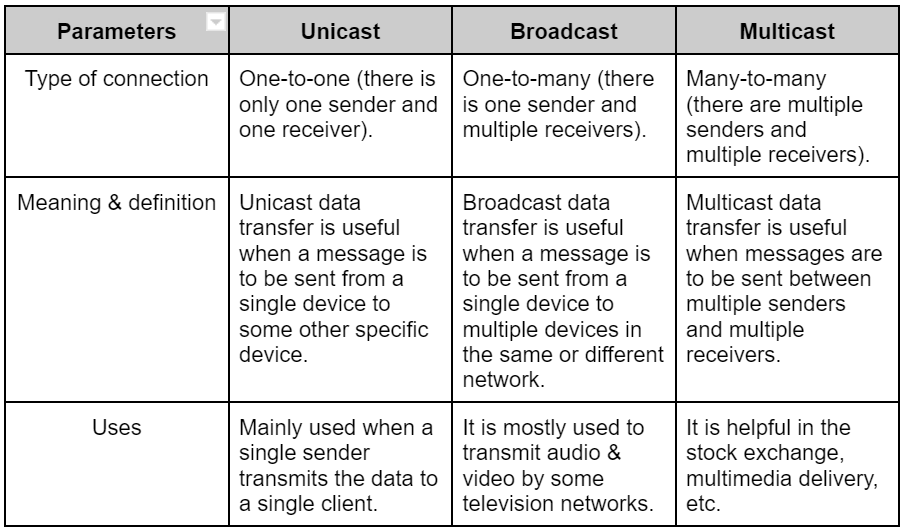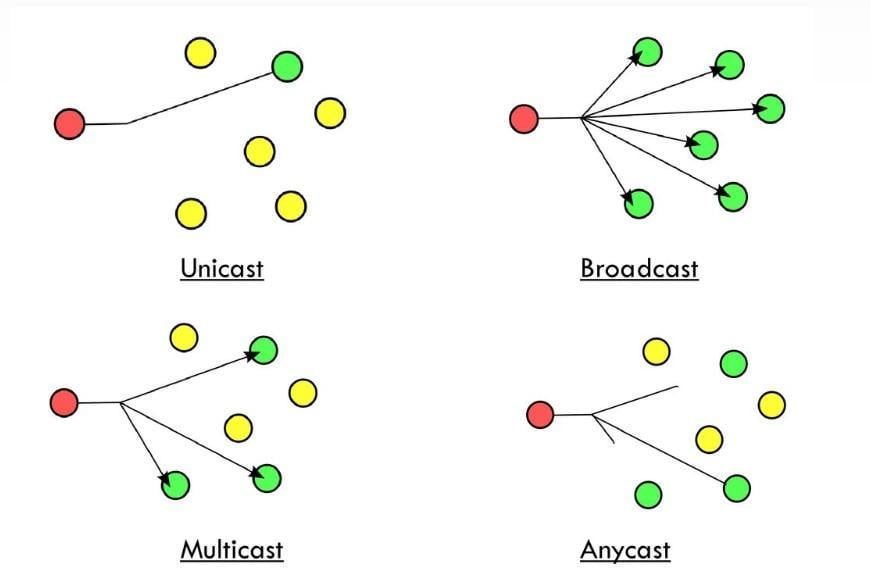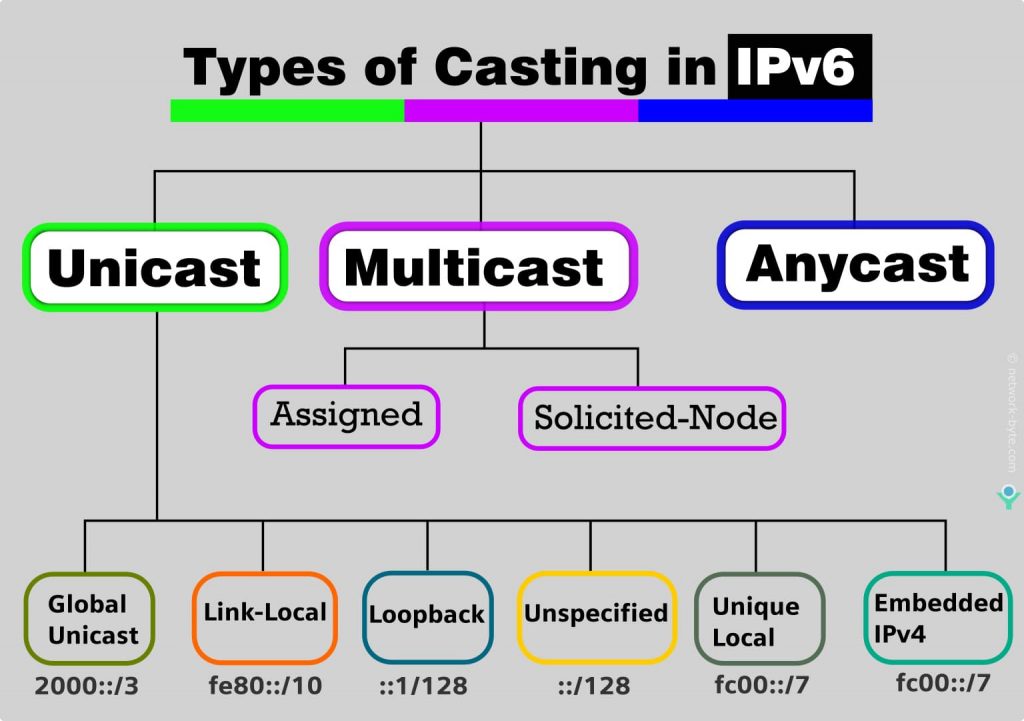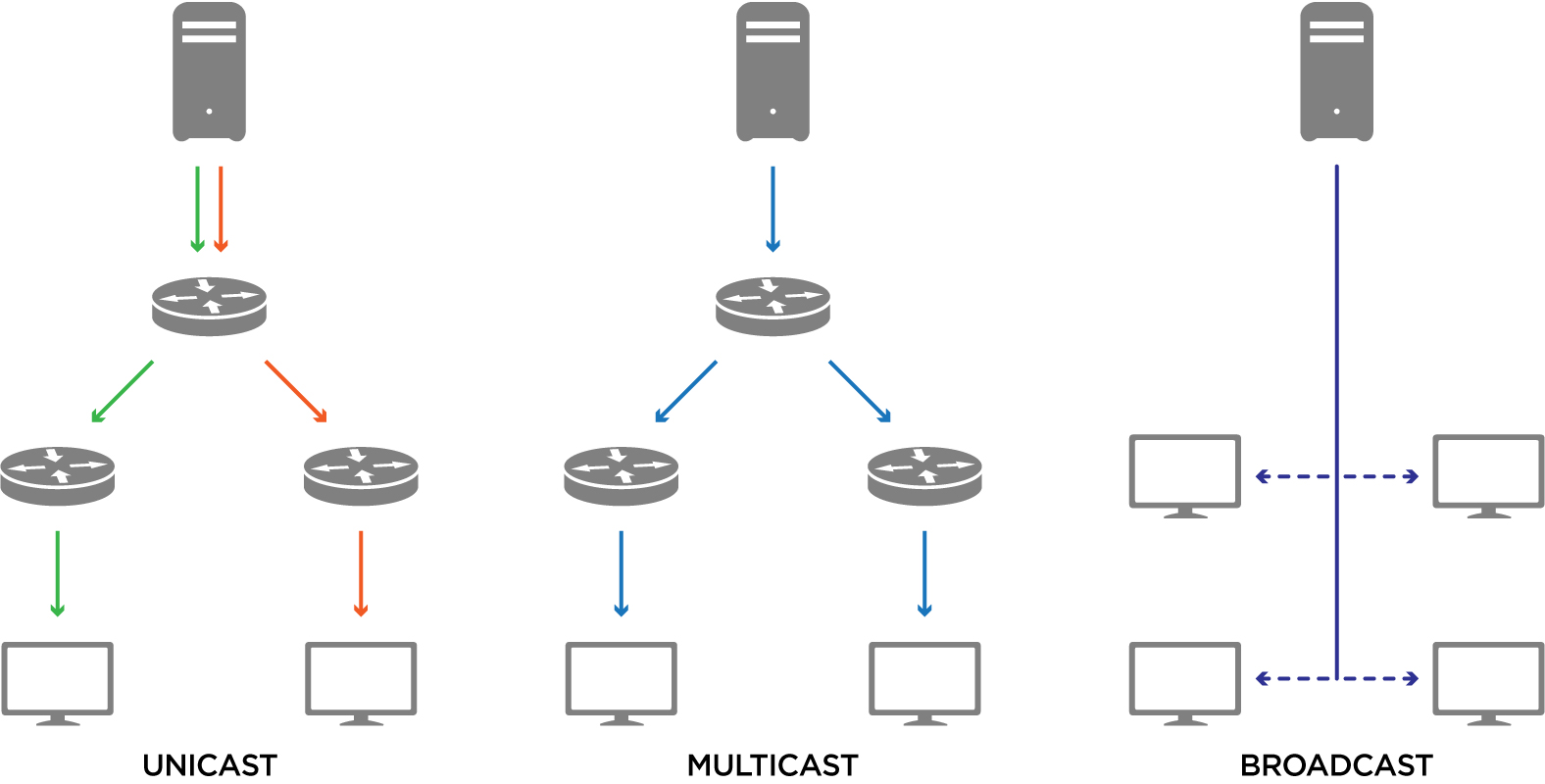UnicastBroadcastMulticastAnycast NetworkByte

Difference between Unicast,Broadcast and Multicast Coding Ninjas
单播(unicast)、组播(multicast)、广播(broadcast)的区别,单播、多播和广播单播"(Unicast)、"多播"(Multicast)和"广播"(Broadcast)这三个术语都是用来描述网络节点之间通讯方式的术语。那么这些术语究竟是什么意思?区别何在?1.单播:网络节点之间的通信就好像是人们之间的对话一样。

Unicast Multicast Broadcast Anycast and Incast Traffic Types Orhan Ergun
Multicast Transmission (One-to-Many) When the data is transmitted from a single source host to a specific group of hosts having the interest to receive the data, it is known as multicast transmission. Multicast can be more efficient than unicast when different groups of receivers need to see the same data. Example − Multicast is the technique.

Unicast, Multicast, dan BroadCast Write Your Skills
Multicast. Multicasting addresses messages for a specific group of devices in a network. Note that, even if a group contains all the devices in a network, multicast is theoretically different from the broadcast. This difference consists that, in the multicast case, devices effectively subscribe to receive messages.

What is Unicast, Broadcast, Multicast & Anycast? Broadcast, Ipv4
Depending on how many devices an address represents, it can be classified in three types: unicast addresses, multicast addresses, and broadcast addresses. A unicast address represents a single device in the network. A multicast address represents a group of devices in the network. A broadcast address represents all devices in the network.

UnicastBroadcastMulticastAnycast NetworkByte
Broadcast, unknown-unicast and multicast traffic (BUM traffic) is network traffic transmitted using one of three methods of sending data link layer network traffic to a destination of which the sender does not know the network address. This is achieved by sending the network traffic to multiple destinations on an Ethernet network. As a concept related to computer networking, it includes three.

Unicast, Multicast, and Broadcast Addresses Study CCNA
unicast / multicast / broadcast ユニキャスト、マルチキャスト、ブロードキャストとは コンピュータネットワークで通信を行う場合、通信相手の数によって以下の3種類の通信に分類できます。

What is the use of IP Directed Broadcast? Network & Security Consultant
Unicast, multicast, and broadcast are address types. A unicast address represents a single interface. A multicast address represents a group of interfaces. A broadcast address represents all interfaces of the local network. Each frame contains two MAC addresses: a source address and a destination address.

Moved Temporarily
Multicast: In multicasting, one/more senders and one/more recipients participate in data transfer traffic. In this method traffic recline between the boundaries of unicast (one-to-one) and broadcast (one-to-all). Multicast lets servers direct single copies of data streams that are then simulated and routed to hosts that request it.

Perbedaan Unicast, Multicast, dan Broadcast
This helps a network switch to distinguish between unicast and multicast addresses. One example of an Ethernet multicast address would be 01:00:0C:CC:CC:CC, which is the address used by CDP (Cisco Discovery Protocol). 3. Broadcast Addresses. Broadcast addresses represent all devices on the LAN. Frames sent to a broadcast address will be.

Examples of broadcast, multicast, and unicast. Download Scientific
The IP multicast requires support from various other protocols such as Internet Group Management Protocol (IGMP) and Multicast routing for the working. Also, Class D stays reserved for multicast groups in the case of Classful IP addressing. Difference Between Unicast, Broadcast, and Multicast in Computer Network. Here is a list of the.

Diferença entre Unicast, Multicast e Broadcast
Unicast only sends the data to one receiver, but broadcast sends the same data to all receivers connected in one LAN. Moreover, if you want to share some private or unique information with another person, you must use unicast network but not the broadcast. Here is a table to give you a clear comparison of unicast vs multicast vs broadcast.

BROADCAST Broadcast, Ipv4, Networking
• Changing multicast data into unicast data i.e. if there are n receivers then n unicast transmissions will follow. This method is called Directed Multicast Service (DMS) [3]. This was further studied by Feng et al. [4] who proposed that the I-frames of video are transmitted using DMS while the remaining frames use the legacy multicast.

Unicast vs Multicast vs Broadcast What's the Difference? Haivision
Compared to unicast transmission, the multicast transmission delivers the same content to multiple receivers simultaneously in a close area [7]. It alleviates redundant traffic load and decreases the traffic consumption [8]. Therefore, the idea of multicast D2D communication has received great attention [9].

Unicast vs Multicast vs Broadcast What Are the Differences?
Multicast: Multicast is the middle ground between unicast and broadcast. Multicast traffic is destined to a "group" of hosts, called "multicast group". Hosts register into a multicast group in order to receive the traffic which is destined to that group. Multicast is used in Video over IP communication for example.

unicast multicast anycast ipv6 Education network, Ipv6, Technology
In computer networking, unicast is a one-to-one transmission from one point in the network to another point; that is, one sender and one receiver, each identified by a network address. [1] Unicast is in contrast to multicast and broadcast which are one-to-many transmissions. Internet Protocol unicast delivery methods such as Transmission.

Unicast vs. Multicast vs. Broadcast What's the Difference?
In IPv6, we have Unicast, Multicast and Anycast. The concept of Unicast and Multicast are same in IPv4 and IPv6, except the changes in IPv6 Layer 3 addresses used for broadcast & multicast and the Layer 2 address used for multicast. Layer 2 address used for IPv6 multicast traffic starts from "33:33:" (in Ipv4, it is "01:00:5e").